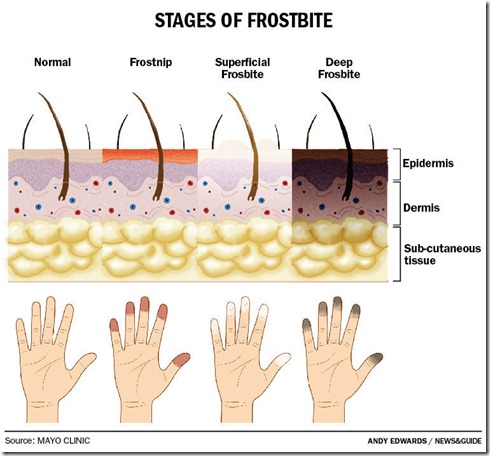Bebout Family Medicine
Available when you need us!332 North Court Street
Morganfield, KY 42437Monday - Friday
See our Office Hours PageDo you know all you need to about frostbite?
Frostbite is the best known cold related illness/injury. It is common, but for the most part, completely preventable. I felt the need to put this out there as we are about to have another blast of Artic weather. Here is what you should know.:
Frostbite
Frostbite is freezing of the skin and underlying tissues. It is more likely to occur on exposed skin but can occur with clothing in place. The most commonly affected areas include fingers, toes, chin, ears, cheeks and nose. Symptoms include cold, numb skin progressing to red, white, bluish-white or grayish-yellow discoloration. The skin can turn waxy and hard. Blistering is common during the rewarming phase. The damage progresses in stages:
- Frostnip – this is very mild frostbite with numbness and some pain/tingling on rewarming. No damage occurs.
- Superficial frostbite – Reddened skin that may turn white- May be some pain on rewarming. This will usually be followed by blistering of the skin.
- Deep Frostbite – affects all layers of the skin and underlying tissue. All sensation is lost including that of pain and discomfort. You have loss of use or incoordination of muscles and joints. Rewarming brings severe blistering followed by blackening of skin as the tissue dies.
Risk factors
There are several conditions that put you at higher than normal risk of frostbite. These are:
-
Previous history of frostbite
-
Alcohol/drug use
-
Young or old age
-
High altitude
-
Diabetes
-
Smoking
-
Dehydration
-
excessive sweating
Prevention of frostbite
- Dress in loose, light, comfortable layers: Multiple layers with clothing that is not too tight is a must.
- Protect your head – Scarves or a face mask will help protect vulnerable skin.
- Protect your hands and feet. – make sure your feet stay dry. I think mittens work better than gloves but keeping the skin covered is the most important.
- Keep yourself well hydrated. Alcohol and cold activities is a no no.
Treatment
The mainstay of treatment is rewarming of the tissues. As thawing occurs, extreme pain can set in. Pain medication is a must. The wounds are generally treated as burns with dressings, removal of dead tissue, antibiotics and surgery. Sometimes a clot busting drug may be given.
The important point is that you do not want any of this so protect yourself from injury.


I am new to Massachusetts I’ve lived in California my entire life up until now. Not sure why I seem more prone to painful frostbite or if I have poor circulation. The last out broad upon my middle finger turning white and completely numb. It’s now in the tingling pins and needles stage. What are some measures I can take to prevent this or something worse happening?
Thank you in advance
Sorry Carla. I have been letting the blog slide. I will try to be better in the future. There are several things that can lead to this but primarily it all boils down to circulation. This may depend on age, smoking, genetics, etc. The primary care for this is prevention. If you are prone then you have to be one step ahead. Protect your hands with gloves or portable heaters. Don’t smoke. Avoid direct contact with wind or cold. Sorry that there are not much other measures.
Bought, not broad